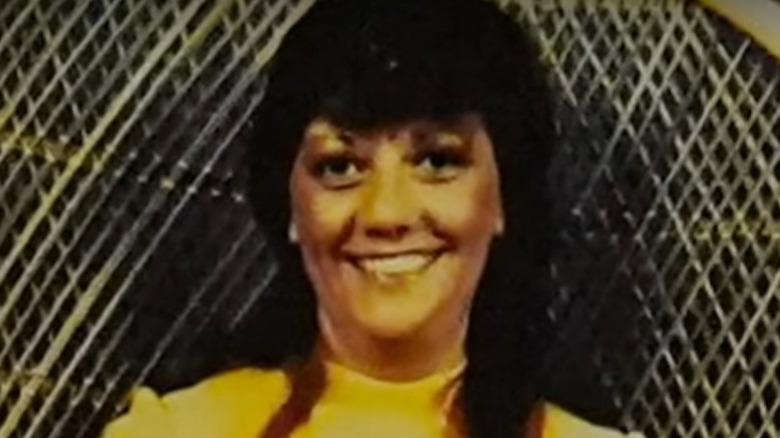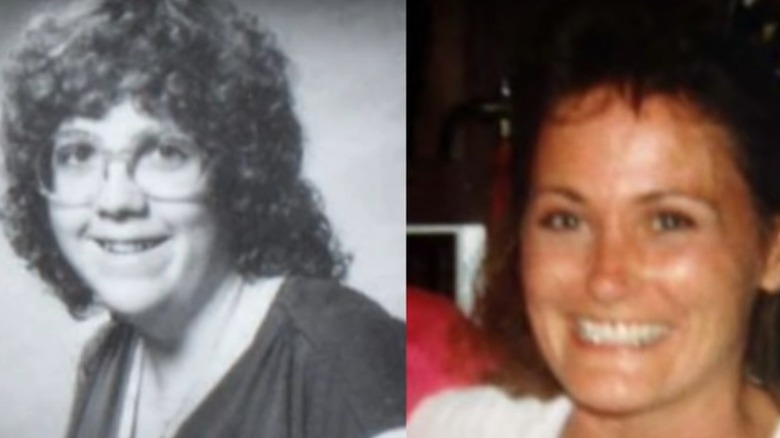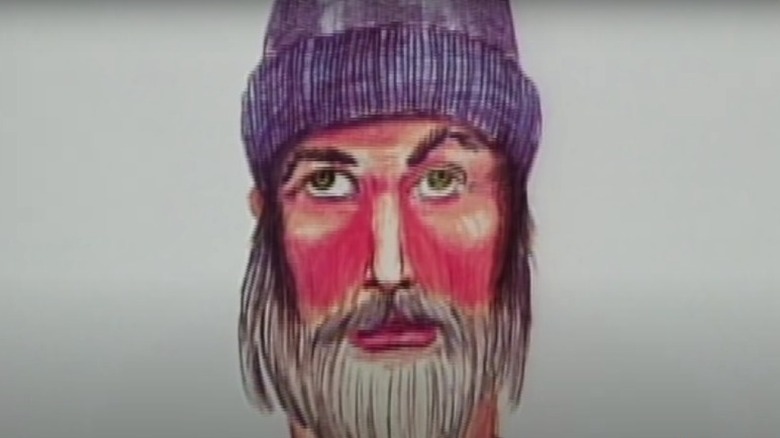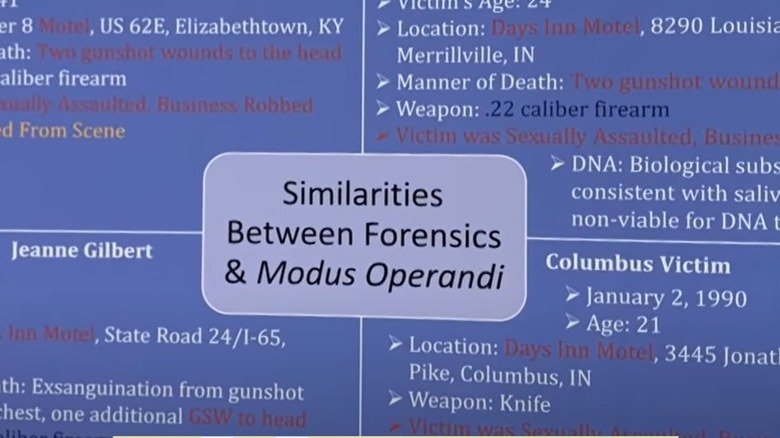The Untold Truth Of The I-65 Killer
Before the arrest of the Golden State Killer in 2020, not many people would have thought of genealogy databases as a way to solve cold cases. Collecting DNA from crime scenes has been the norm for years, and while it can easily be used to link a perpetrator from one crime to the next, it fails to identify them if they don't have any DNA samples on file. There have been a good number of cold cases that have been solved after DNA samples were taken from suspects, of course. But an emerging tool of law enforcement is the ability to link DNA from a crime scene to potential matches they can find in various databases that consumers have been using to trace family history and find missing or unknown relations.
CNN writes that this tool is called "investigative genealogy." Investigators will already upload crime scene DNA to various legal databases to find matches. But now they are doing the same with databases from popular public sites to try to get breaks in cases. After law enforcement had all but given up on solving the I-65 killings, this tool provided a valuable break in the case.
There are still many questions about this case that are unanswered. But one that might be lingering over the heads of many that are involved is how someone who committed such ghastly acts over years could go undetected for decades and live a seemingly normal life?
Greenwell's first arrest was in 1963
The killer identified as the I-65 Killer was named Harry Greenwell. By all accounts, he lived a fairly typical life as a retiree in the small Iowa community he died in. A retired railroad worker from the Canadian Pacific Railroad, Greenwell retired from his position of 30 years in 2010 (via MSN). He was an avid gardener, even selling his wares at local farmers' markets. His obituary reads like someone's elderly grandfather or uncle passing away, with references to him being a fan of college sports and his love of thoroughbred horses (per Legacy).
What wasn't written about in this tribute to his life were the numerous crimes he committed. While no one knew of his involvement in the I-65 murders (of course), authorities knew that Greenwell had an extensive criminal history dating back to the early 1960s. In 1963, Greenwell was arrested for armed robbery. In exchange for a guilty plea, USA Today reports that he was given a two-year sentence and five years probation. But he was arrested again not long after his release, this time on a charge of sodomy. It wasn't until 1969 that he was released from prison.
There are no records showing that Greenwell was arrested for any other crimes for more than a decade after his release. But history shows that Greenwell wouldn't stay off the radar of authorities forever.
Greenwell's first wife died in a fire
From what can be gleaned from various online sources, Harry Greenwell seemed to have settled down in the 1970s. It was reported by The Independent that his widow, Julie Jenkins, spoke of how she was Greenwell's third and final wife. Without divulging any information on the second wife, she did give some tragic details about how his first marriage came to an end in 1978.
His young bride, 23-year-old Terry Jo Hastings Greenwell, succumbed to injuries sustained in a house fire on April 28, 1978. When asked if she thought there was foul play involved, Jenkins was skeptical. She noted that Greenwell was clear across the state at the time of that fire, working on his job with the railroad. Jenkins went on to say that she recalled that the fire was ruled accidental and may have been born out of negligence on Terry Greenwell's part.
He was arrested in 1982 for robbery but escaped custody
Harry Greenwell began to slip back into his criminal patterns. In 1982 he was arrested once again on a charge of robbery. CBS 4 News reports that he was picked up by police in Vernon County, Iowa, on a robbery charge. But Greenwell seemed to be a little too much for authorities to handle at that time. Both CBS 4 News and CNN report that Greenwell was able to escape jail not once, but twice.
Despite the charge and the two escapes, Greenwell wasn't behind bars for very long. CBS 4 News tells us that Greenwell was incarcerated at Anamosa State Penitentiary in Iowa in August 1982. For reasons not yet disclosed he was then transferred to Kentucky State Reformatory, being released on December 5, 1983. This marked the last time Greenwell served time in prison, though it wasn't the last time he was arrested.
In March 1989 Greenwell was arrested for a traffic violation. Later that month, he was arrested on a domestic assault charge and had a restraining order issued against him. Within a month he violated the terms of the restraining order twice and was sentenced to 15 months of probation. In October 1998 he was arrested for felony drug possession and was arrested again in November of that year for violating another restraining order (per Yahoo News). The charges were dropped against him in late 1998.
The first murder tied to him was committed in 1987
The first known murder victim of Harry Greenwell was Vicki Heath. On February 21, 1987, she was working the overnight shift at a Super 8 Motel in Elizabethtown, Kentucky, where she earned a living. American Crime Journal reports that police received a phone call from a concerned motel guest just before 7 a.m. The caller reported that they had gone into the motel office and described a scene that sounded as if a physical altercation had taken place. They also reported that the clerk was nowhere to be seen.
Police responded and walked into the motel office, noting that it indeed looked as if a scuffle had occurred. Thinking that maybe several men had been involved and out of concern for the missing clerk, they conducted a search of the grounds. In the back of the building, under a light dusting of fresh snow, lay the lifeless body of Heath. She had been beaten and appeared to have been executed by a shot to the back of the head. Footprints leading away from her body and to a set of tire tracks were seen, but the snow melted too quickly for them to be taken as evidence.
An autopsy revealed that Heath had been shot by a .38 caliber handgun. One bullet had exited her skull and was able to be recovered and entered as evidence. The medical exam also reported that Heath had been sodomized.
Two of his victims were killed on the same day
As far as authorities are aware, Greenwell didn't commit another murder for over two years. But something may have motivated him to make up for lost time, as the next time he struck, he killed two women on the same night.
Mary Margaret "Peggy" Gill clocked in to work her shift at the Days Inn in Merrillville, Indiana at 11 p.m. on March 2, 1989. The last anyone saw her alive was when she checked in a guest between 1:30 a.m. and 1:40 a.m. on March 3. American Crime Journal reports that at 2:00 a.m., a guest attempted to check in but, after finding no one at the desk, went to another area motel. After her manager hadn't heard from her before her scheduled shift was to end, the police were phoned. After searching the hotel, they found that the register was emptied of money. They also discovered Gill's nude body in a vacant wing. She had been shot twice in the head.
50 miles away in Remington, Indiana, 34-year-old Jeanne Gilbert reported to her job at the local Days Inn. Some time after giving a guest a 4 a.m. wake-up call, she disappeared from her post. The police were called and noticed the register had been pried open. But Gilbert was nowhere on the property. They discovered her naked body in a ditch off of a county road. She, like Gill, had been raped and shot (per American Crime Journal).
Greenwell is also known as the Days Inn Killer
With one known murder already under his belt, Harry Greenwell didn't waste too much time before striking again. Including the murder of Vicki Heath in 1987 and up to his last suspected attack in 1991, Greenwell had three murder victims and two other possible assault victims (via MSN). Though these happened along or near the I-65 corridor, these murders and attacks revealed an M.O. that garnered Greenwell another name he is known by.
All of Greenwell's victims were working alone at motels when they were attacked. But while Heath was employed at a Super Eight Motel, his next known victims were all employees of different Days Inns along I-65 (per Yahoo News). All three of his victims after Heath were brutally attacked in the same manner as his first victim and left for dead.
Because the majority of the victims worked for the same motel chain, Greenwell became known as the "Days Inn Killer."
Greenwell's surviving wife thinks he may have more victims
Imagine sharing a life with someone, only to discover that they savagely murdered several women. That's precisely what happened to the surviving spouse of Harry Greenwell several weeks ago. When the FBI contacted Greenwell's widow about his being the I-65 Killer, she claims to have been "pretty dazed" by the revelation. Yahoo News reports that Julie Jenkins, who was married to Greenwell for nearly 20 years, stated that Greenwell had anger management issues but that she never would have suspected him of being a cold-blooded killer.
Jenkins further spoke that she felt for the families that had to suffer at the hands of her late husband. When asked if she thought there could be more victims out there, Jenkins said that it was a possibility. She stated, "When you know what you do about serial killers, they generally don't just stop — so I hope, no, I pray, that there aren't going to be more victims that he's linked to."
If she's correct about serial killers not stopping, that leaves a chilling gap between his last known attempted murder in 1991 and his death more than 20 years later. Officials close to the case agree, and they are reported as looking more closely at other cold cases in other states that could yield more victims of Greenwell.
Greenwell also sexually assaulted victims
Harry Greenwell's attacks weren't just limited to murdering his victims. And after his crime scenes were fully investigated and the coroners' reports finalized, it was determined that the I-65 Killer was motivated by more than just random murder.
As mentioned before, Vicki Heath was sodomized before she was shot to death. This M.O. was present during Greenwell's attacks on both Jeanne Gilbert and Peggy Gill. They were both sexually assaulted before being killed by rounds fired from a small-caliber firearm (per MSN). It's not yet been determined if rape was the motivating factor in Greenwell's crime spree. But it was certainly present during the three known murders that his DNA has been linked to. And it was also part of an attack on a woman on January 2, 1990.
Unnamed in reports to protect her privacy, the victim reported to police that a man attempted to kill her while she was working overnight at a Days Inn in Columbus, Indiana. Her would-be assailant raped her, then attempted to stab her to death. Yahoo News reports that the woman was, fortunately, able to escape her attack and gives a good description of him. Among other features, she described him as being over 6 feet tall and having green eyes. His right eye was witnessed as being "lazy." DNA from this victim matched the DNA that was collected from Heath, Gilbert, and Gill.
One attack was committed along I-90
Though Harry Greenwell had his DNA linked to attacks on four women along the I-65 corridor, he may be responsible for more than investigators are currently aware of. In fact, an attack that was eerily similar to Greenwell's M.O. was reported a year after his attempted murder in 1990. Thankfully, this victim also was able to escape with her life.
Along I-90 in Minnesota (via American Crime Journal), a woman (whose identity has been concealed for her protection) reported to police that she'd been sexually assaulted and stabbed. MSN reports that the description she gave investigators painted a picture of a suspect that was very similar to the one that had given the year before by another victim in Columbus. This woman's attacker was 6' to 6'-2" which matched the attacker's height from the 1990 assault. He was wearing a flannel shirt and blue jeans and had graying hair.
What makes the suspect seem the most like Greenwell was the fact that he was also described as having green eyes, with a right one that appeared to be lazy.
Greenwell had a long marriage and two children
From statements made by his surviving spouse, it's known that Harry Greenwell was on his third marriage. Despite his known criminal past, Julie Jenkins married Greenwell, claiming that though he had served time in prison for robbery on two occasions, she thought people deserved second chances. And that's exactly what she gave him. Jenkins said she was married to the man who would later be identified as the I-65 Killer for nearly 20 years, and she describes him as being a supportive spouse, especially throughout her bout with breast cancer.
The two didn't have children together, but Greenwell did have stepchildren through Jenkins. Jenkins also revealed a bit more than what his obituary listed as survivors. From that, it's known that he had a surviving son and daughter. But Jenkins fills in a bit more of the puzzle pieces.
The Independent reports that Greenwell had adopted the daughter of one of his previous wives, though Jenkins didn't indicate which one. She also noted that his son was with a separate wife.
Greenwell died in 2013
Harry Greenwell retired from his job at Canadian Pacific Railroad in 2010 and made a seemingly quiet life for himself in the tiny community of New Albin, Iowa. The town of fewer than 500 people knew Greenwell as a man who grew his organic produce and sold them at a nearby farmers' market (via The Independent).
According to death records, Greenwell died in 2013 at the age of 68 after battling an unspecified form of cancer. The obituary in the Louisville Courier-Journal describes a man much different than the monster that has now been linked to the murders and sexual assaults of at least three women. One line that stands out among the many paragraphs that eulogize Greenwell is the one that reads, "His spirit will live on in many by good deeds he offered."
Greenwell may have been known for good deeds in and around the small town of New Albin. But for the rest of the world that came into contact with him while he was alive, he will most likely now be remembered as a thief, a rapist, and a serial murderer.
DNA tied Greeenwell to his crimes posthumously
Detectives take DNA evidence and enter it into a national database called CODIS. This will attempt to find an exact match and also look for ancestral matches. You share a lot of your genetic makeup with siblings, parents, and other relatives. If CODIS turns up a link to a relative, it helps investigators narrow down their search. In the case of the Golden State Killer, he was caught by distant cousins who had their DNA on a public database. This allowed investigators to build family trees from that DNA, and to whittle their suspects down to the killer (per The Daily Mail). The online database that was used is called GEDMatch and differs from other online platforms.
While websites like Ancestry and 23 and Me will collect DNA samples through the mail from willing consumers, they do not publicly share their database of DNA with just anyone. They will turn over samples with a court order, making it more difficult to use them as a source. The Atlanta Journal-Constitution reports that 23 and Me has never had an order to turn DNA samples over, as of 2018, and Ancestry has had only 9 requests.
At this point, its known that Harry Greenwell had a close relative's DNA linked as an ancestral match (per Yahoo News). But it has not been revealed which database was used, or which relative provided the sample. But regardless, his identity was discovered, even though he wasn't revealed as the I-65 Killer until nine years after his death.












